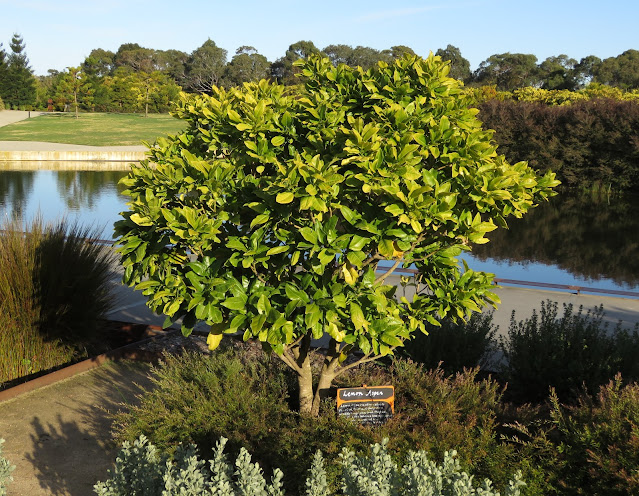Lemon Aspen has citrus notes but only hint of poplar
Aspen is a common name applied to at least three different kinds of poplar (Populus) in the Northern Hemisphere. It's not unusual to appropriate such common names for Australian species with a similar look, or sometimes similar wood texture.
The Lemon Aspen is an odd one though. The lemon part makes sense because the fruit is yellow and acidic, described as having 'a wonderfully tart lemon taste with a hint of grapefruit'.
The botanical name is Acronychia acidula, with 'acidula' meaning slightly acidic. Acronychia is a genus of about 50 species from Asia, Australia and the western Pacific, classified in the citrus family, Rutaceae - another connection to the word 'lemon'.
The poplar connection, though, seems a bit obscure for this species. 'Aspen' is applied to a few of the Acronychia species so I'm assuming for at least some it is a reference to their habit and overall form resembling a poplar.
In the Lemon Aspen I suspect that part of the name has just been carried over as a generic tag, with the more descriptive 'Lemon' tacked on the front. Certainly, the large glossy leaves and compact form of the plant in the Australian Garden at Royal Botanic Gardens Melbourne conjure up more of your typical citrus than poplar.
It's worth noting that the Lemon Aspen can grow to 15 metres in the wild, so ours is presumably trimmed for the reason Angus Stewart gives on his website, to make it easier to collect fruit. Also, I expect, for landscape aesthetic reasons.
It's the fruit that attracts most attention, which was sadly absent when I took my photos back in early October. The yellowing leaves wet by spring rain perhaps demonstrating that its doesn't entirely enjoy the Victorian winter.
The fruit, and possibly other parts of the plant, are used by First Nations Peoples in its native habitat on the mountain ranges of northern Queensland, where it grows in rainforest from about sea level to just over 1000 metres in altitude.
Published information on traditional uses is scarce but it's interesting that the European colonisers of this region were quick to incorporate the fruits into a refreshing drink. Fruit-eating pigeons are also apparently attracted to the tangy lemon flavour.
 |
| One of three 'Bush Citrus' stamps issued in 2019 (reproduced from https://www.anbg.gov.au/stamps/stamp-acronychia-acidula-2019.html
|
There has been some production of this fruit commercially on the Atherton Tablelands in the last decade or two, as well as smaller ventures in south-east Queensland and northern New South Wales. The attraction is not only the distinctive flavour but also high levels of antioxidant - more than blueberries - folate, zinc and iron.
Sometimes called the Southern Lemon Aspen, the close relative Acronychia oblongifolia, which extends further south into New South Wales and eastern Victoria, is also harvested for its smaller, less lemony, fruit. More often that species is known as the Yellow-wood, presumably a more accurate description of its favourable attributes.
Postscript: As noted by Maarteen Christenhusz on Facebook link to this post, "It might be called aspen because of the similarity in wood quality". This is true of many early colonial names in Australia, and a good point!




Comments